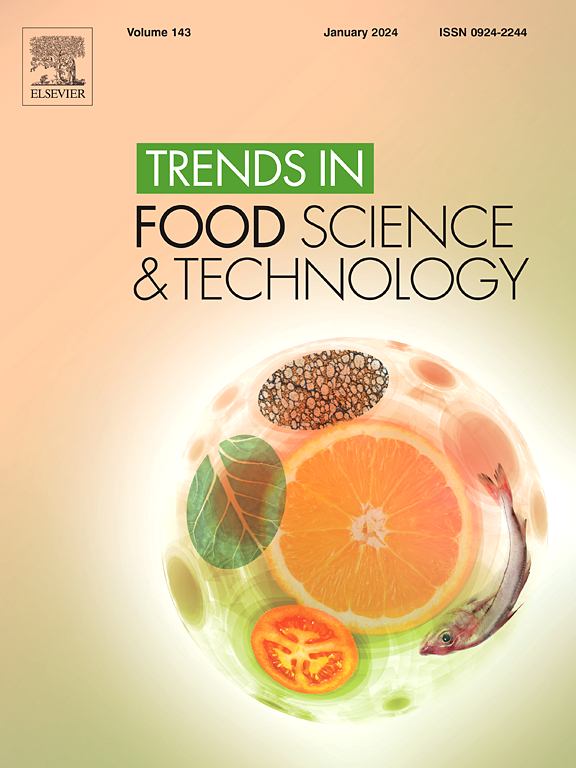计算机视觉、物联网、数字孪生在食品质量安全评估中的创新融合
IF 15.1
1区 农林科学
Q1 FOOD SCIENCE & TECHNOLOGY
引用次数: 0
摘要
确保食品质量和安全是公共卫生和经济稳定的关键优先事项。传统的食品质量评估方法虽然有效,但往往是劳动密集型的、破坏性的或缺乏可追溯性和透明度。深度学习和计算机视觉的最新进展引入了数字智能、经济高效和自动化的解决方案。本文介绍了深度学习和计算机视觉的典型工作流程,从数据采集、数据预处理到模型选择、训练和评估验证,总结了深度学习和计算机视觉在食品不同领域的应用,如图像分类、目标检测、图像分割和图像生成,以及针对不同任务的模型优化策略。重点介绍了物联网(IoT)、数字孪生、计算机视觉和深度学习技术在食品行业的应用。此外,本文还讨论了迁移学习和模型压缩方法,并综述了轻量级模型和嵌入式系统在食品工业中的应用。计算机视觉、深度学习、物联网和数字孪生等技术的创新融合增强了食品的可追溯性和透明度,促进了可持续发展。云计算和大数据技术的发展推动了这些技术的深度融合,实现了粮食生产决策的实时、准确和动态。展望未来,未来的研究重点应放在提高标注数据集的可用性和质量,增强模型的可解释性和鲁棒性上。本文章由计算机程序翻译,如有差异,请以英文原文为准。
Innovative integration of computer vision, IoT, and digital twin in food quality and safety assessment
Background
Ensuring food quality and safety is a key priority for public health and economic stability. Traditional methods of food quality assessment, while effective, are often labor-intensive, destructive or lack traceability and transparency. Recent advances in deep learning and computer vision introduce digitally intelligent, cost-effective and automated solutions.
Scope and approach
This review presents a typical workflow of deep learning and computer vision, from data acquisition and data preprocessing to model selection, training and evaluation for validation, and summarizes the applications of deep learning and computer vision in different areas of food, such as image classification, object detection, image segmentation, and image generation, as well as model optimization strategies for different tasks. The applications of Internet of Things (IoT), digital twin, computer vision, and deep learning technologies in the food industry are highlighted. In addition, this review also discusses transfer learning and model compression methods, and reviews the applications of lightweight models and embedded systems in the food industry.
Key findings and conclusions
The innovative integration of technologies such as computer vision, deep learning, IoT, and digital twin has enhanced food traceability and transparency, and promoted sustainable development. The advancement of cloud computing and big data technologies has promoted the deep integration of these technologies, enabling real-time, accurate and dynamic decision-making in food production. Looking forward to the future, the focus of future research should be placed on improving the availability and quality of labeled datasets, enhancing the interpretability and robustness of model.
求助全文
通过发布文献求助,成功后即可免费获取论文全文。
去求助
来源期刊

Trends in Food Science & Technology
工程技术-食品科技
CiteScore
32.50
自引率
2.60%
发文量
322
审稿时长
37 days
期刊介绍:
Trends in Food Science & Technology is a prestigious international journal that specializes in peer-reviewed articles covering the latest advancements in technology, food science, and human nutrition. It serves as a bridge between specialized primary journals and general trade magazines, providing readable and scientifically rigorous reviews and commentaries on current research developments and their potential applications in the food industry.
Unlike traditional journals, Trends in Food Science & Technology does not publish original research papers. Instead, it focuses on critical and comprehensive reviews to offer valuable insights for professionals in the field. By bringing together cutting-edge research and industry applications, this journal plays a vital role in disseminating knowledge and facilitating advancements in the food science and technology sector.
 求助内容:
求助内容: 应助结果提醒方式:
应助结果提醒方式:


